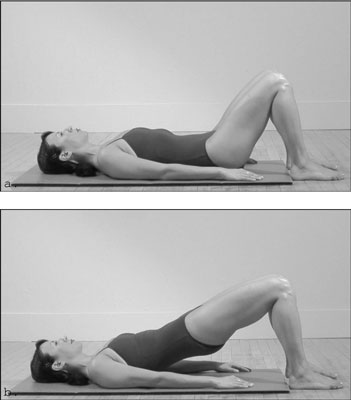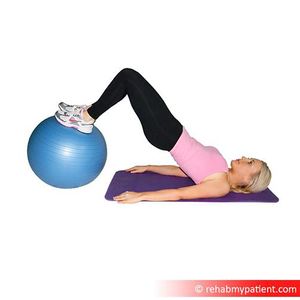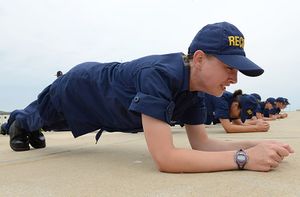Bridging
BridgingOriginal Editor - Daan Vandebriel Sheik Abdul Khadir.
Top Contributors - Sheik Abdul Khadir, Lucinda hampton, Kim Jackson, Uchechukwu Chukwuemeka, Daan Vandebriel, Lilian Ashraf, Mostafa Shahien, Garima Gedamkar, WikiSysop, Evan Thomas and Claire Knott
Introduction[edit | edit source]
Bridging exercise (supine) is an exercise which increases muscular strength of the hip extensors and promotes trunk stability. When performed correctly, a bridge exercise can help promote better posture,
- It is often prescribed for patients with back pain , and increases the activities of trunk stabilization muscles such as the internal oblique, external oblique, and erector spinae muscles.[1]
- Individuals with back and hip pathologies are often taught to perform the bridging exercise in the crook-lying position, elevating the pelvis off the floor. This exercise is particularly useful for facilitating pelvic motions and strengthening the low back and hip extensors, and it enhances motor control of the lumbo-pelvic region.[2]
Technique: The patient lies down with the back, knees in full flexion and feet flat on the floor and close to the buttock. Then the patient lifts hip off the floor towards the ceiling/sky as high as possible.
Viewing
These 2 videos (2 minutes of viewing) introduce you to the supine bridge.
| [3] | [4] |
Analysis[edit | edit source]
The movement analysis of bridging / pelvic bridging reveals the movement comprises of : Hip Extension; Lumbar extension; and Posterior Pelvic tilt.
It is a closed chain exercise
Variations [edit | edit source]
The term bridge exercise sometimes includes the prone bridge (plank) and side bridge (side plank)[5]
The supine bridging exercise variations include:
- With pelvic tilt
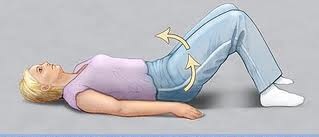
- With straight leg raising (SLR)

- With SLR and Glutei contraction
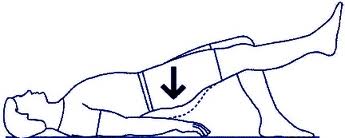
Core Activation[edit | edit source]
The bridging exercise is an effective way to improve core strength eg clients with LBP,
- Different kinds of bridging exercises has been evaluated, the authors concluding that bridging exercise in the prone position (plank) may be a more effective method of enhancing trunk muscle activities.[6]
- A study by Jeong-Oh Yoon et al, found that bridging exercise on unstable surface or with single leg lift hip abduction facilitated the muscles activity of internal oblique and rectus abdominis. While no significant increase was found in back muscles multifidus and erector spinae. Internal oblique muscles is connected indirectly to the lumbar spine through the thoracolumbar fascia, so its activation increases the stiffness of the lumbar spine. It should be noted that, rectus abdominis muscle activity increase on the same side of the lifted leg. (Right single leg lift bridging exercise increased right rectus abdominis activity).[7]
- A study by Chan-Myeong Kim et al, found that External oblique and erector spinae muscles activity increased with hip inversion 25 degrees while gluteus maximus muscle increased activity in 25 degrees hip external rotation.[8]
- Performing the bridging exercise on unstable surface increases the muscles activity of the deep abdominal muscles (transverse abdominis and internal oblique) compared to on stable surface.[9]
- Some points that could enhance the exercise include performing the abdominal draw in maneuver before the bridging exercise to prevent excessive lumbar lordosis. Also maximum expiration which was found to increase the abdominal muscles activity compared to resting expiration during side bridge exercise.[10][11]
References[edit | edit source]
- ↑ Min YE,Sin HC,Tae SK. Effects of Bridging Exercise on Different Support Surfaces on the Transverse Abdominis. Journal of Physical Therapy Sciences, 2013; 25:1343–1346.
- ↑ Eun-Mi Jang, Mi-Hyun Kim,Jae-Seop Oh. Effects of a Bridging Exercise with Hip Adduction on the EMG Activities of the Abdominal and Hip Extensor Muscles in Females. Journal of Physical Therapy Sciences, 2013; 25:1147–1149.
- ↑ Bridging. Available from: https://www.youtube.com/watch?v=syoirIxumiY
- ↑ Bridging with progressions tightness Available from: https://www.youtube.com/watch?v=qaoa9V-bL9c
- ↑ Musculoskeletal Key Electromyographic Analysis of Deep Trunk Muscles During Sports Activities Available:https://musculoskeletalkey.com/electromyographic-analysis-of-deep-trunk-muscles-during-sports-activities/ (accessed 22.11.2022)
- ↑ Kong YS,Cho YH,Park JW. Changes in the activities of the trunk muscles in different kinds of bridging exercises. J Phys Ther Sci. 2013;25(12):1609-12
- ↑ Yoon JO, Kang MH, Kim JS, Oh JS. Effect of modified bridge exercise on trunk muscle activity in healthy adults: a cross sectional study. Brazilian journal of physical therapy. 2018 Mar 1;22(2):161-7.
- ↑ Kim CM, Kong YS, Hwang YT, Park JW. The effect of the trunk and gluteus maximus muscle activities according to support surface and hip joint rotation during bridge exercise. Journal of physical therapy science. 2018;30(7):943-7.
- ↑ Cho M. The effects of bridge exercise with the abdominal drawing-in maneuver on an unstable surface on the abdominal muscle thickness of healthy adults. Journal of physical therapy science. 2015;27(1):255-7.
- ↑ Ishida H, Watanabe S. Maximum expiration activates the abdominal muscles during side bridge exercise. Journal of Back and Musculoskeletal Rehabilitation. 2015 Jan 1;28(1):81-4.
- ↑ Gong W. The effects of the continuous bridge exercise on the thickness of abdominal muscles in normal adults. Journal of physical therapy science. 2018;30(7):921-5.
